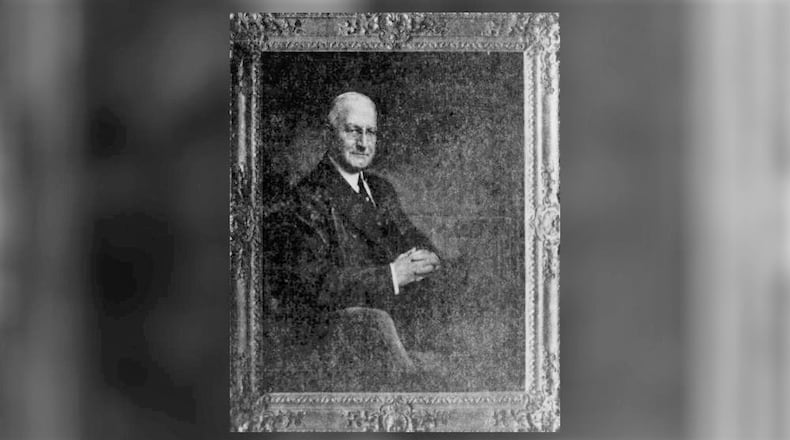There is also Deeds Point MetroPark, where you can get a great view of the downtown Dayton skyline. The park is located at the meeting of the Great Miami and Mad Rivers and features paved trails that run along them.
Col. Edward Deeds definitely made his mark on Dayton. Here are some things to know about the man who did so much for the city.
Early Life
Edward Andrew Deeds was born on March 12, 1874, to parents Charles and Susan Deeds and grew up on a small farm near Granville, Ohio. By his early teens he was running a plow with a three-horse team.
He always led his class in school, and by the time he was 14, he took the teacher’s examination and was certified to teach orthography, reading, writing, arithmetic, geography, grammar, physiology and U.S. history.
During high school, Deeds played varsity football. As fullback and tackle, he captained the team.
After graduating from high school, he attended Denison University, graduating in 1897 as valedictorian. He received a Bachelor of Science degree in electrical engineering.
Next, Deeds went to Cornell University seeking a graduate degree but stopped attending classes after one summer and deciding instead to start his professional career.
In 1898, Deeds took a draftsman’s job with Thresher Electric Company in Dayton. His salary was $6 a week. A year and a half later he was superintendent and chief engineer of the company.
Inventor, engineer and industrialist
In 1899, Deeds was hired by National Cash Register Company. He planned the electricity generation plant and the electric installation for the factory. This was the first of three career stints Deeds spent with NCR.
Deeds next took a year away from NCR at Niagara Falls, where he took a job at a factory that would produce Shredded Wheat, the breakfast food. Deeds then returned to Dayton and a job at NCR as the head of development and construction.
Deeds hired Charles Kettering in 1904 and the resulting product developments helped get NCR back on top. Deeds handled the business end of the company while Kettering was a gifted inventor.
Kettering and Deeds in 1908 began to work in Deeds’ barn, a small machine shop behind his home at 319 Central Avenue. Others joined them in researching, and the group came to be called “The Barn Gang.”
In 1909, Deeds and Kettering founded Dayton Engineering Laboratories Company (DELCO), focusing on automobile parts. Kettering left NCR in 1909 to work full time on his inventions.
With the help of machinist Fred Schmitt, Deeds built his own car, which he dubbed the Suburban Sixty. The car was built with interchangeable bodies, a convertible for summer use and a hardtop for winter.
Deeds began thinking of ways to improve automobiles. He began discussing various ideas with Kettering. The “Barn Gang” successfully developed the new car ignition system and self starter in 1910.
The Suburban Sixty was turned over to Kettering to use as a guinea pig. It became the first automobile to use a self-starter, and helped pave the way for the formation of DELCO. Not long after, the first order of the new ignition system was sold to Cadillac.
Deeds resigned from NCR in 1915 when DELCO needed his full-time attention as well.
A couple years later the pair sold the company which eventually became a part of General Motors. By 1917, both men had become millionaires.
Other ventures
During the early 1920s, Deeds played a major role in reorganizing the Sugar Industry in Cuba. He had visited the county as a guest of Gordon Rentschler, whose Hamilton-based company made machinery used by struggling sugar companies.
Deeds plan was to consolidate the dozens of small companies. Over the years, the number of companies grew smaller and smaller. In 1937, three of the largest companies had merged to form General Sugar Estates, Inc., with Deeds as president.
In 1925 Deeds moved on to the Niles Bement Pond Company in New England. The company had not been doing well after World War I and needed an executive who could turn the company around.
After successfully saving that company, another struggling company called. once again it was NCR, and Deeds headed back to Dayton.
In 1931 Deeds returned to NCR, this time as president. He retired in 1957 at age 83.
Miami Conservancy District
After the Great Flood of 1913, Deeds helped set up the Miami Conservancy District. He hired Arthur Morgan to create a flood prevention plan. Getting cooperation from all the communities along the river was difficut, as was getting the needed laws passed. Deeds pushed through opposition and got the Conservancy Act passed and dams built. The system became a model for flood prevention around the world.
Years later, Deeds said, “My part in the establishment of the Miami Conservancy District, the erection of the dams and their subsequent operation, has been to me the most important single responsibility of my life...for I do not know what could take precedence in any man’s activity over the safety and welfare of half a million people.”
A colonel
In 1917, Deeds resigned from DELCO and entered the Army during World War I. He was given the rank of Colonel and Chief of the Equipment Division of the Signal Corps, in charge of aircraft and all accessories. Deeds also used his connections at McCook and Wright Fields in Dayton to aid in Army aircraft research.
Along with Orville Wright, Charles Kettering and H.E. Talbott, Deeds formed the Wright Airplane Company. This company became a major producer of airplanes during World War I.
Deeds once sought advise from the Wright Brothers about building a landing strip on his property. In 1916 Deeds built the landing strip at his home, Moraine Farm. It was believed to be the first private airstrip.
Deeds died in 1960 and is buried in Woodland Cemetery and Arboretum.
Credit: Chris Stewart
Credit: Chris Stewart
About the Author





